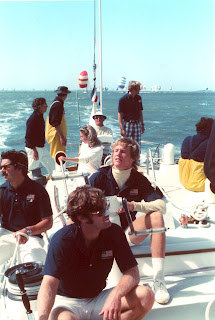The All American Offshore Team is focused on offshore sailing. I can spend more time speaking about sailing offshore having done a fair amount and loving it. I am probably showing my age but I do not see clearly how this works as a system. Perhaps I am showing that I am indeed not part of the Facebook generation as stated by Russell Coutts. What I see is a system that throws money at a perceived problem to solve that problem. It is so far from the way I grew up and what I came to love about offshore sailing; that this remains an unresolved issue in my mind. I see this a merely a vehicle to feed professional sailing.
Most top boats are now crewed by entirely paid crews and I am not going to try to turn back the hands of time. Besides the boats are now so technical, in many cases it is frankly safer to have a professional crew who are familiar with the systems.
My memories and stories are so far from the world today, it makes me question my relevance. During my early years I worked building boats, masts, sails, rigging. Studied weather; sailed as many classes as possible(dinghys,catamarans, big boats), broadening my understanding of sailing as much as I could at the time.



